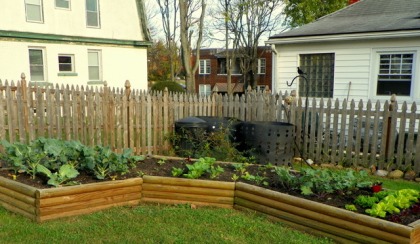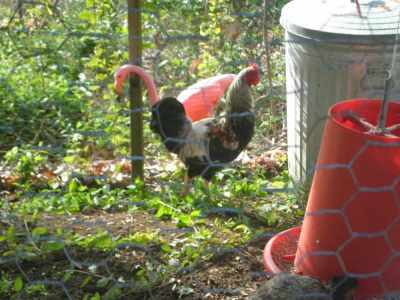Filed under: Back to Basics, Redefining Prosperity, Transitioning, Voluntary Simplicity | Tags: beekeeping, buckwheat honey, Decluttering, Gardening, lower blood pressure, nature, nematodes, pollinators, Redefining Prosperity, simple living, simplicity, symbiotic relationships, the good life
Transitioning to a way of life that is easier on the planet, easier on my digestive system, and easier on my pocketbook gives me reasons enough to make the effort but it’s also become increasingly clear to me that it’s also become a way of life that is simpler, and even slower, in many respects. Part of that may very well be due to the fact that as my body grows older it’s physically slowing down on its’ own, but I honestly feel that I owe most of the magic of slower living to the deliberate choices I make daily, rather than to an aging body. I’m still perfectly capable of getting worked up into a full blown frenzied melt down…it’s just that now I recognize what’s truly important to me and that cramming more activity into my days doesn’t tend to make me any happier.
I wrote here recently about my new hive of bees I’m honored to be caretaking. I am here to testify that nothing, absolutely NOTHING in this world makes me move more slowly or purposefully, nor be more aware and more mindful than when I work in my bees. 15 minutes with them is worth an hour on the meditation cushion! And I may have cancer but my blood pressure is perfect these days. I owe it to taking time for things like this; to slowing down enough to finally ‘see’ what I’ve been looking for.
I had a raised bed in my garden that was contaminated with nematodes: years ago I would’ve applied an overnight chemical solution that would’ve not only immediately killed the nematodes, but would’ve destroyed every other living organism in the bed too. I tried to re-mediate the problem last summer by growing a special marigold in it that supposedly is toxic to the microscopic buggars there. A slower, but much healthier, solution. But over the winter my daughter’s cat decided to use that same bed as a litter box so I knew I’d have to leave it fallow again this summer in order to overcome the health risks associated with that. Enter the bees…
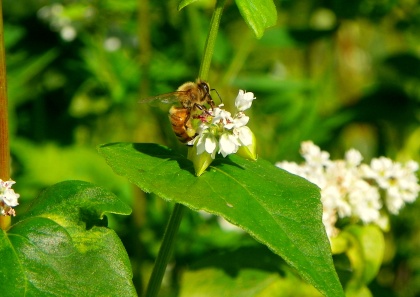 When life gives you cat shit, plant buckwheat!
When life gives you cat shit, plant buckwheat!
Not only is buckwheat a primo crop for honey-making, it’s also a good green manure crop that will not only offer the bees plenty of nectar during the dry summer season, but will also add lots of organic matter to my soil in this troubled bed once I turn it under. I could watch these little pollinators ‘work’ this grain all day, buzzing slowly, yet methodically, through the pretty stand of white flowers. Symbiotic relationship is a biological term used to describe the relationship between two species that depend on each other for survival. I love the symbiotic relationships going on here between myself and my bees. Spending time with, and as a part of, nature can certainly help our transition to a lower-energy, slower-paced, world.
![20160610_102404[2]](https://tennesseetransitions.files.wordpress.com/2016/06/20160610_1024042.jpg?w=420)
The bees have already increased my strawberry, blueberry, blackberry and elderberry crops four-fold over previous years, and now they are making honey for my bread and pollen for my allergies. Watching their gentle buzzing lowers my blood pressure and encourages me to grow beautiful flowers for them, all to be enjoyed from the kitchen window while doing the dishes. Un-bee-lievable!
But it ain’t just the bees that have helped me slow my life down. Redefining prosperity for myself has boiled down to this: buying less, using less, wanting less and wasting less has resulted in a simpler, slower life too. A simple life isn’t about seeing how little we can get by with-that’s poverty-but how efficiently we can put first things first…When you’re clear about your purpose and your priorities, you can painlessly discard whatever does not support these, whether it’s clutter in your cabinets or commitments on your calendar. People sometimes tell me that de-cluttering is really hard for them. Yeah, it can be, for sure. But it’s true that when you set your values and priorities, that process becomes much easier. And the side effects are nothing short of miraculous.
![20160606_195800[2]](https://tennesseetransitions.files.wordpress.com/2016/06/20160606_1958002.jpg?w=420)
Fishing at sunset off the shore of Lake Pontchartrain in New Orleans just last Monday…slowing down to the speed of life…
This blog hasn’t been very active lately, even though I think about it a lot. (that counts doesn’t it?) It occurred to me today that part of the reason I’ve been quiet is because I’m back into that summer time groove of gardening and “puttin’ food by”. It’s such a natural and routine part of my life that I guess I considered it rather, well, too routine and not interesting enough to write about. So, I tried to look at my daily activities through your eyes, hoping to see some ‘transitioning patterns’ or ideas that I might share with you.
Transitioning to a way of life that involves using less fossil fuels and adapting to a warming climate can cover a lot of activities, from adapting our daily routines to the vagaries of the weather to eating cooler, lighter foods in summer than those we eat during the colder months. I’ve found that working in the heat of the day makes me pretty miserable so I’m waking earlier and earlier to beat the heat. Right after breakfast I walk to the community garden to inspect the live traps we set each night for the raccoon mama and her teenage son (or daughter) that are waiting, right along with us, for the corn to ripen. So far, we’ve only caught two smallish rats, but regardless of what live animal gets tricked into going into traps, I don’t want them to suffer, like I do, in the heat of the day, so I go early to check, and then to get my days’ gardening chores completed. I finish just as the sweat begins to drip off my chin. After a brief rest at home, I take my daily walk with the dog because I worry about her burning her paws on the asphalt or overheating in her black fur coat. Days are spent in front of the fan, snapping, slicing, dicing-and drinking sweet apple mint tea 😉
This week I’ve been…
canning beans…
![20140709_165912[1]](https://tennesseetransitions.files.wordpress.com/2014/07/20140709_1659121.jpg?w=168&h=300)
drying zucchini slices…

and chopping peppers for drying…
![20140711_075333[1]](https://tennesseetransitions.files.wordpress.com/2014/07/20140711_0753331.jpg?w=190&h=292)
We harvested the onions this week, so I’m taking advantage of the sun to cure them for a few days…
![20140710_202622[1]](https://tennesseetransitions.files.wordpress.com/2014/07/20140710_2026221.jpg?w=168&h=300)
while cooking our supper too!
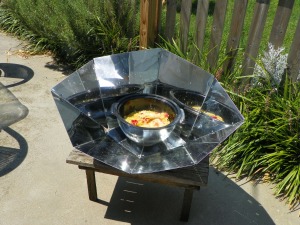
We aren’t doing any baking these days because heating the oven is simply not worth it. My west-facing kitchen windows can really allow a lot of heat in in the late afternoons, even with the shades drawn, so if I’m not using the solar cooker, I cook my evening meal before that happens, generally right after lunch. That leaves me all afternoon and evening to pursue other projects. Last night I cut down a small tree to make way for a greenhouse that’s going to be put in its’ place. Tonight I moved all the rockers and crap things off the front porch and scrubbed the accumulated road dirt and dust off the siding and floor, all while enjoying the shady side of the house in the barefoot comfort of cool hose water. Tomorrow evening I plan to attend the opening reception of a new art exhibit at a nearby downtown gallery called “Lens on the Larder: Food Ways of Appalachia”; I’m already looking forward to walking there in the cool of the evening and enjoying some local foods, photography and stories. Who says transitioning to this way of life is somehow difficult or hard? It often just requires some simple adjustments to our schedules, menus or clothing.
Before the days of central heating and air, everyone worked and slept by the rising and setting of the sun. Farmers and field workers often enjoyed their main meal, or ‘dinner’, at noon, giving them an opportunity to fully refuel after a morning’s work outside, while also offering them a respite until later in the afternoon when the sun wasn’t as high. Front porches served as the warmer-months living rooms, and summer kitchens were screened affairs where the days’ cooking, eating and canning took place. Corn was shucked and beans were broken while sitting under the shade of a tree. Folks were completely tuned in to the sun, the rain and the seasons. I’m trying to adapt to that way of life as well, and though I enjoy turning on the AC at times, I’m happiest with the windows open. Thinking back, I attended an un-air conditioned school and lived in a house without it, all while growing up in central Alabama. We didn’t suffer, it was just part of summer!
I recently covered my upstairs skylight with newspaper to prevent the sun from shining in so brightly, and it really did help with the heat buildup up there! Each evening, when the outside temperature drops to a lower point than the inside air, I turn on the window fans up there to further cool things off. We sleep on the first floor of our home, which is naturally cooler, and have gotten so used to the ‘white noise’ that the fan provides that it’s become like a sleeping pill for us. One summer while I lived in California, the state was experiencing ‘rolling brownouts’ where the electrical usage was cut during the hottest parts of the day. During those times our office ‘adapted’ by allowing us to wear shorts and sandals, changing lunch break times and doing those tasks that didn’t require electricity: filing, phone calls, and data entry on our battery operated lap tops got us through. Our own electric company is working towards a similar setup here in NE TN, where we can voluntarily sign up for ‘time of day’ usage rates, which will be lower than regular rates. It saves them power and us money, but it’s all about adapting any way you look at it. For me, adapting to the heat just means doing my work in the cooler hours, eating meals on the porch, and napping or reading in the heat of the day. I enjoy a greater sense of resiliency by changing with the seasons and find it’s kinda cool actually!
Filed under: Closed Loop Systems, Community Gardens, Composting, fall gardening, Growing Food, Healthy food, Local Food, organic gardening, Seasonal Eating | Tags: Compost, food, growing food, Hoop House, nature, raised beds, root crops
“Fall has always been my favorite season.
The time when everything bursts with its last beauty, as if nature had been saving up all year
for the grand finale.” Lauren DeStefano
Fall is my favorite season too, even though it’s bittersweet for me, knowing what lies just beyond it. I’m still working on my summer to-do list, and now I’m in the midst of my fall list! Many of you have asked me to let you know what’s going on in the garden during each season, so I hope this helps, although I suspect I should’ve written all this out back in August. I hope it will give you an idea of where you need to be now anyway.
All of my raised beds in my community garden plot are now planted to either fall crops or crimson clover, which I like as a cover crop for winter.

I’m harvesting broccoli and lettuces, beets, August-planted potatoes, and carrots there, with the kale, cabbage and cauliflower ready in another couple of weeks. Brussels sprouts remain a mystery to me, but I still plant them anyway. Maybe someday I’ll actually get some sprouts from them!

At home, I’ve started harvesting bok choy:

I always feel like it’s a race to get the late summer plantings almost to harvest stage before the fall equinox, because things really slow down by then. This proves to be especially tricky with Longkeeper tomatoes! I have full-grown plants loaded with green tomatoes now that were set out in August,. If they can just begin to turn pink before our first frost, they will slowly continue to ripen inside the house, allowing us to have fresh tomatoes until about Valentine’s Day- if we don’t eat them all before then. The key is that they won’t ripen if picked green, they must have at least a slight blush of color to continue ripening. I usually plant them out in July, so don’t have as many this fall as in years past, but we’ll still have enough to last til Christmas with any luck. Longkeeper -the name is accurately descriptive. Even though they’re not as sweet and juicy as a summer ripened fruit, they are far, far better than ANY grocery store tomato you might buy in mid winter. And by golly, they’re local 😉 Some Farmer’s Market vendor is missing the boat by not selling them during the winter months.
I finished preparing my final bed today, turning in compost and shredded leaves. I’ll add some bone meal to the holes when I plant my garlic there at the end of October, but today I just raked it smooth and planted winter lettuces and spinach, neither of which will be ready until spring. With a simple little hoop house over that bed, those plants will just sit there, almost dormant, right in the row, until late winter. When the days begin to lengthen just a bit, that spinach and cold hardy lettuce will burst to life and offer us fresh greens, just about the time the kale and swiss chard grow tough and we’re tired of them anyway. Last, but not least, the parsnips that were planted way back in July won’t be harvested until after several hard frosts, but before the ground freezes solid (boy did I learn that the hard way!). The freezes sweeten them, and then they’ll keep in the refrigerator for a very long time; I consider it one of nature’s mysteries that just as my vegetable drawers are finally empty of all the fruits and veggies they held all summer, along come the greens, apples, nuts and root crops to fill ’em up for the winter.
I set up another compost bin today, and will let the one we filled during the summer cook and decompose all winter, hopefully ready for use in the spring, with this new one full and ready for use by next fall. And so the gardening cycle continues. After all this intensive digging, planting, harvesting and storing it’s nice to know we’re moving into a quieter, slower pace in the garden for a few months. God willing, the wheel of good health and fortune will continue to turn and the seed starting trays will be full again come February. Happy Fall Ya’ll!

Filed under: Buy Local, Climate Change, Community Building, Community Gardens, Creating Community, Global Warming, Healthy food, Liveable Communities, Local Food, Peak Oil, Plant based diet, Resilience, Sustainability | Tags: Bakery, Bread, Farmer's Market, nature, the good life
I haven’t posted here for over 2 weeks…just about the same amount of time I was sick with a virus that I’m pretty sure I picked up from Michael, who’s pretty sure he picked it up while he was in the hospital recently. To say his cancer has kicked his ass-and mine-would be putting it mildly. But we are both doing ever so much better this week and my brain is once again percolating with things to write about.
I use this blog to harp on share with you ideas that we can apply to our lives as we transition to a different world from that which we’ve all grown up in; it will surely be a lower energy future, on a planet with serious environmental degradation and climate change, with globalization a hard-earned lesson from the past. Two of the best ways that I’ve found to make that transition to ‘the good life’ involve building resiliency through more localized economies and skill sets and through more interdependence in our individual communities. Both solutions are key to creating more livable communities and offering us a more fulfilling and sustainable life, regardless of what our futures may hold.
If you doubt any of what I wrote in that last paragraph, I have ‘proof’ to offer, not just theory. Here’s my ‘story’. Michael and I have been largely self-sufficient in terms of health, finances and most aspects of our daily lives for a very long time. We liked that smug snug feeling of being self-reliant. Then we both got sick and had to ask for help with lots of things-from cutting grass to daily meals. (Not feeling nearly as invincible now.) But somewhere along the way, the magic of community kicked in and we were not only helped but uplifted by our circle of friends and community. That circle of love and friendship held healing power as strong as the cancer treatments themselves! Never underestimate the value of cards, emails, prayers, books, visits, phone calls, jars of soup and loaves of bread to someone in need. Using an overused phrase here: “They are priceless”.
Now that I’ve seen first hand the value of communal care, I intend to work harder at being an advocate and practitioner of the concept. As a society it seems we’ve gotten so far removed from ‘knowing thy neighbor’ and feel we don’t have time or energy to develop the friendships and relationships that can be so helpful and valuable to each and every one of us, in good times or in bad. So when I hear about a community-based effort to enrich my life, I intend to share it with you. My hope is that the sharing will inspire us all to look for ways to build our own communities whether they be with neighbors, coworkers, church groups, gamers, gardeners or simply the gay couple next door. There’s strength in numbers.
Now I want to let you know about a new entrepreneur in my neighborhood. Tyler Selby lives in the next block down from me and has started baking and selling artisan breads at the Farmer’s Market in Johnson City. They are fabulous, healthy and go a long way towards making our soups and other plant-based meals filling! I know $6 a loaf may seem a bit high but consider this: Cut into 12 thick slices and then frozen to keep it fresh, we’re able to enjoy the loaves Tyler bakes for 6 meals. Not so bad eh? Of course supporting his efforts will hopefully help his business grow. I’d lots rather walk down the street to get a fresh-baked loaf of bread from someone I know than to get it anywhere else. Kinda like they do in the rest of the world. In a world without refrigeration or electricity, daily bread baking is the norm. (I hear there’s another nearby neighbor that sells fresh fried fish sandwiches out her back door on Fridays but I haven’t found her yet. But I digress…) Tyler plans to apply for a plot in the Carver Peace Gardens next year so that he can grow some specialty grains for his breads. Since he lives only half a block away from the gardens, it seems a perfect fit. The community gardeners, the bakery, and my neighborhood all stand to benefit from Mr Selby’s plans. My secret, long-term plan for that community garden has always been to build an outdoor, wood-fired bread oven so he has tapped into some of my own life blood with his little bakery. I’ll keep you updated on any progress made and perhaps the idea of a community oven may actually come to pass. In the meantime, look for The Selby Bakery at the Farmer’s Market!
 .
.
Another lovely example of community building popped up online this week. A friend of mine has created a website that highlights some of the natural and beautiful places that her family enjoys visiting in our little corner of NE TN, with the hope that others can use the resources she’s compiled there to find those wild places as well. I smell the makings of a hiking club and family friendly outings in the air! Here’s the web address: http://freshairfamily.weebly.com/ This same friend also took her windfall of organic apples to the community cannery in Telford yesterday where she and her son and a friend processed the fruit into jars and jars of applesauce. Using community resources to enhance our lives is one of the many rewards of all this!

All this is to simply say: Michael and I are living proof that sometimes community is NECESSARY to get things done, to heal, or just get by. Just don’t wait ’til the going gets tough to create those necessary communities-do it today. Hilary was right: It takes a village!
Filed under: Closed Loop Systems, Composting | Tags: nature, recycling, reusing, Waste reduction
It’s 8 PM on election night, and I decided to write a new post here to take my mind off the voting results for a while. It’s not my intent to discuss politics (or religion) on this blog, so if you’re here for that, moooove on.
Next Thursday, November 15th Johnson City Public Works and Keep Johnson City Beautiful will be holding a recycling symposium called “Closing The Loop” at The Millennium Center, from 8:30 AM-1:30 PM. Local and regional recyclers will be sharing their ‘best recycling practices’ with us. I understand there will be two tracks for this event: One for residents, the other for businesses, so there promises to be something for all of us. We will learn how our local efforts affect our world resources, but I am hoping specifically to find out how we might start a city-wide metals recycling program. Tickets are ten dollars and include lunch-served on something recyclable or reusable I assume. If it comes on styrofoam I’m going to protest~ loudly! Registration is required for this event, so you can call Eva Hunter at 423-979-6318 to have your name added, and then you can pay for your tickets at the door.
Closing the Loop.. what exactly does that mean? It refers to the continuous life cycle of a product from production, consumption, recycling and ultimately, returning to production. Examples of closing the loop include the use of recycled materials instead of raw materials during the manufacture of new products or the recycling of food wastes into composts which are then used to help in agriculture and food production. Nature operates under the condition of limited and finite resources. It therefore reuses, recycles, and rebuilds everything it needs to sustain life. Take trees, for example. They drop their leaves in fall, those leaves break down and return nutrients to the tree, which in turn take the nutrients from the soil to grow and make new leaves. In nature, one organism’s waste is another’s food or building material. In nature, (which really is perfect), everything is interrelated and part of the natural food chain. It’s the only way nature can thrive and survive. We humans are the only part of nature that break that loop by taking more than we return. EXCEPT this little guy…
Living in a Peak Oil, lower energy world that is rapidly undergoing environmental and economic changes means that we MUST learn to create closed loop systems for everything we produce, buy and use. I want to live in a place that is based on local resilience, rather than oil dependence. Please consider supporting our city’s efforts to teach us how to do this! If WE show up for these kinds of events, they’ll offer more of them. However much I can do, we can do more. However much you can do, we can do more.
Filed under: Community Gardens | Tags: food, nature, plants, raised beds, soil compaction, soil erosion, traditional beds
We finally got around to planting a small fall garden last month, and tomorrow I plan to harvest the first bok choy from it, with kale and lettuces hopefully by the weekend. Take a look:
A second raised bed, with brick sides, is filled with cabbages and broccoli, but I’m not sure if they were planted in time to produce full heads before freezing weather. So I’ll put a hoop house over them soon, where they’ll continue to slowly grow until very cold weather settles in. (The stakes shown on the wagon were soaked in the bucket of wood preservative and are drying there.. they’ll be used to stabilize the new bed.)
After gardening both with and without raised beds, I definitely prefer ‘raisin’ the bar’. Here’s the pros:
1. No soil compaction: if you’re walking around on top of your raised beds, well, you’re an idiot.
2. No soil erosion: The soil stays within it’s boundaries and doesn’t get scattered into the paths or other areas
3. Easier on the back -’nuff said
4. Less Labor: Raised beds require more initial labor than traditional beds but less labor once established. Constructing the bed takes time, but once the bed is constructed and filled with soil, it only requires minimal maintenance.
There are some disadvantages too, such as being more costly to install rather than planting directly into the soil, needing more frequent watering (due to better drainage), and densely planted beds can be more prone to fungal problems. Nematodes and disease organisms may also buildup in the soil, although you can diminish these issues by growing different plants in the bed each year, which is wise to do in traditional gardens as well. And obviously, tilling is out of the question, unless you have a small hand held tiller. We donated our big Troybilt Pony tiller to the community garden a couple of years ago where almost all the beds are traditional, and only do light tilling now, with our Mantis, when absolutely necessary. The earthworms and frogs are spared because of the no till methods, and the soil structure maintains its integrity better as well. All in all though, we’re raised bed advocates.
Wood Preservative
Recommended by Organic Gardening Magazine
1. Slowly melt 1 ounce of paraffin or bees wax over low heat in a double boiler (do not heat over a direct flame).
2. Outdoors, carefully pour just under a gallon of solvent (mineral spirits, paint thinner, or turpentine, at room temperature) into a bucket; then slowly pour in the melted paraffin, stirring vigorously.
3. Add 1½ cups boiled linseed oil to the mix, stirring until the ingredients are blended.
4. When the mixture cools, either dip your lumber into it or brush it onto the wood, making sure that you thoroughly coat all surfaces, especially the cut ends. Dipping the boards for 5 to 15 minutes allows the repellent to soak more deeply into the wood.
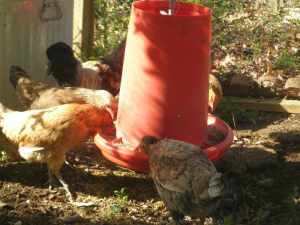 Oh, today was magnificent! Between the beautiful weather and getting a new flock of hens, I am in heaven! These pictures were taken in dappled shade so they’re not very clear, but I so wanted to show off ‘the girls’ that I took them as soon as I got them settled in their new digs late this afternoon.
Oh, today was magnificent! Between the beautiful weather and getting a new flock of hens, I am in heaven! These pictures were taken in dappled shade so they’re not very clear, but I so wanted to show off ‘the girls’ that I took them as soon as I got them settled in their new digs late this afternoon.
But this blog isn’t meant to simply show off my chickens; it’s my attempt to offer ideas that might help others transition to a new way of living that’s significantly more connected, more vibrant and more fulfilling than the one we find ourselves in today. Now is the time for us to take stock and to start re-creating our future in ways that are not based on cheap, plentiful and polluting oil but on localized food, sustainable energy sources, resilient local economies and an enlivened sense of community well-being. And honestly, how much more local does food get than from your own backyard or neighborhood? As a vegetarian, eggs are an important source of protein for me as well as a valuable barter commodity. That’s where the ‘resilient local economy’ part comes in for me. If I have eggs to trade for, say, your pecans, we then are both able to afford the best that money can’t buy with such a trade AND that makes us both more resilient, regardless of the Dow, the elections, the price of gas or anything else that may be affecting our ability to provide for ourselves and our families. As if THOSE weren’t enough reasons, the birds’ manure is an incredibly rich source of nitrogen for my compost piles, which then of course, enriches my garden soil, which the garden plants take up, which end up on my dinner table with the unused bits fed back to the chickens. My intention with this flock is to try to find or grow sources of food for them that don’t depend on ‘store bought’ (read: OIL). I love the closed loop that their existence creates here on my little small holding; it’s called ‘sustainable’ and it’s something I strive for constantly, but often without success in its truest sense. But with this beautiful rooster to fertilize the eggs, sustainable is obtainable!
 Today was the day I’d been waiting for… a warm, sunny day absolutely meant for hanging out clothes! You can see in the picture how the pants are positively dancing they’re so happy to be there! I’ve always loved hanging my laundry out and never even think about buying an electric clothes dryer. Not having one is one less thing to take up room in our small house, one less thing to buy and replace or repair, and one less thing to add to my electric bill.
Today was the day I’d been waiting for… a warm, sunny day absolutely meant for hanging out clothes! You can see in the picture how the pants are positively dancing they’re so happy to be there! I’ve always loved hanging my laundry out and never even think about buying an electric clothes dryer. Not having one is one less thing to take up room in our small house, one less thing to buy and replace or repair, and one less thing to add to my electric bill.
For me, hanging clothes on the line while listening to bird songs brings a sense of peace to my small world every time I do it. Time seems to kinda stand still during the five minutes it takes to hang a load of freshly washed clothes. I’m often amused by watching our resident squirrel run up a nearby tree or happy to hear the pileated woodpecker that lives in our woods drumming on the dead tree that he seems to love, during my morning hangup. And of course, depending on solar rays for drying our laundry necessitates me keeping in tune with the weather, which serves to put me in touch with the garden as well, but it’s the quiet time spent outdoors that I’m most hung up on.
Hanging the wet clothes on a folding rack inside during the winter months raises the humidity in our dry, wood heated home and extends the life of the clothes as well so I’m certainly glad I have that option, but with the return of warm weather, you’ll find me at the clothesline! This morning I saw the curled, green heads of fiddlehead ferns pushing through the earth, and-ta da!- the stinging nettles that I planted on the edge of the woods last summer are also beginning to push up too. Oh yeah, I also found the faded mate to a long-lost sock laying under the lines, hidden by last autumn’s dried leaves.
My grandkids say they’re just “hangin’ out”. Me too 🙂


